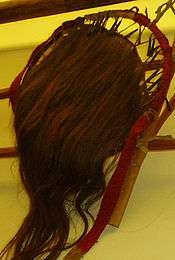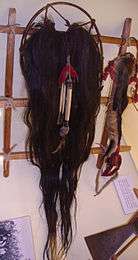Native American scalps at Karl May Museum
The Karl May Museum is a museum in Radebeul, near Dresden, Germany. Opened in 1928, the museum is dedicated to the life and work of German author Karl May (1842–1912), who wrote many books about the Wild West and Native Americans featuring the fictional characters Winnetou (a Mescalero-Apache Chief) and Old Shatterhand (a white European settler).
In 1936, an artist and "Indian researcher" known as Patty Frank (1876–1959; birth name: Ernst Tobis; aliases: Eisenarm, Isto Maza ["Iron Arm"]), donated a collection of 19 scalps to the Karl May Museum. Frank obtained the scalps over a several-decade period during which time he traveled in the United States, sometimes with Buffalo Bill Cody's Wild West shows.[1]
In the summer of 1904 Frank was on tour with the Barnum & Bailey Circus when the show stopped near a Native American settlement. Late one evening, Frank rode to the settlement and, after a long negotiation, bought a Native American scalp from the descendants of Dakota Chief Swift Hawk. Frank bought the scalp, which Swift Hawk obtained in a fight with an Ojibwa (Chippewa), for two bottles of whiskey, a bottle of apricot brandy and $100. The hair of the scalp was decorated with feathers and a pearl-adorned lizard figure. Frank also obtained a scalping knife that had five marks in it, denoting how many enemy scalps Swift Hawk had obtained.[1]
In March 2014, an official with the Sault Ste. Marie Tribe of Chippewa Indians in Michigan called the possession and display of Native American ancestral remains at the Karl May Museum "inappropriate and unacceptable." Said Cecil E. Pavlat, Sr., a repatriation specialist for the Tribe, "These are human remains which should be buried respectfully and should never have been taken from the tribe in the first place." In response, a curator at the Karl May museum said the exhibits are "part of history", and that "it is important to the museum that history isn't being falsified in our exhibition." The curator also stated that the museum is "prepared to have a conversation" with the Tribe. Members of the Chippewa Tribe said they are considering holding a protest at the annual Karl May Festival in Radebeul in May–June 2014.[2]
A campaign to have all Native American remains kept by the museum repatriated to Tribes was launched by Berlin-based journalist and activist Mark Worth.[3]
On March 10, 2014, Pavlat sent a letter to museum director Claudia Kaulfuss, stating: "Contrary to how popular culture likes to present Native Americans, we are not extinct. We are very much alive and feel the display of our Ancestor's Remains at your museum to be very disrespectful, insulting and unconscionable... If the Karl May Museum refuses to cooperate and handle this situation with dignity and respect, those actions will not go unnoticed. I will make every attempt to make the world know of this horrific display and dehumanization of Native Americans. I shall continue to fight for the repatriation of these Ancestors."[4]
References
- 1 2 Hoffman, Klaus. "Zur Geschichte des Karl-May-Museums, seiner indianischen Sammlungsobjekte und deren Präsentation", Karl May Stiftung.
- ↑ Oltermann, Philip. "German museum in row with US activists over tribal scalps", The Guardian, 10 March 2014.
- ↑ (www.dw.com), Deutsche Welle. "Wild West museum in row over Native American scalps - Globalization - DW.COM - 19.03.2014". Retrieved 10 November 2016.
- ↑ Letter from Cecil E. Pavlat Sr., Sault Ste. Marie Tribe of Chippewa Indians, to Karl May Museum, 10 March 2014.
Additional sources
- Hoffman, Klaus. "Zur Geschichte des Karl-May-Museums, seiner indianischen Sammlungsobjekte und deren Präsentation", Karl May Stiftung.
- Oltermann, Philip. "German museum in row with US activists over tribal scalps", The Guardian, 10 March 2014.
- Karl May Museum official site

